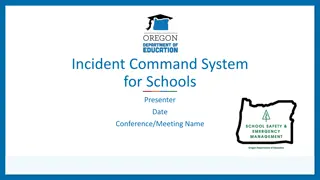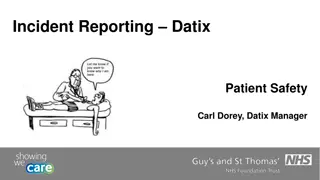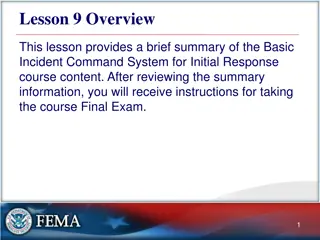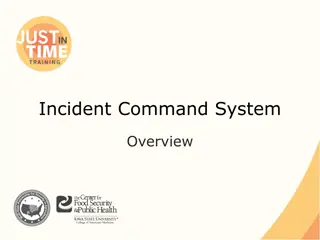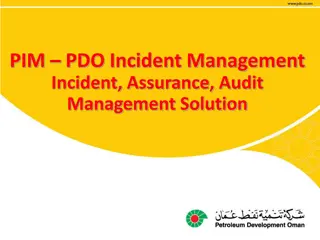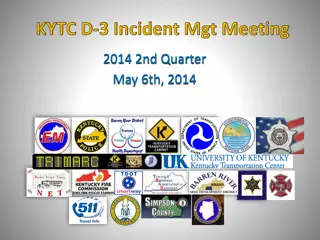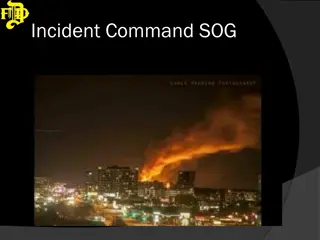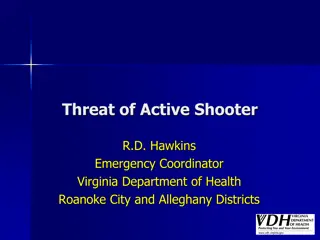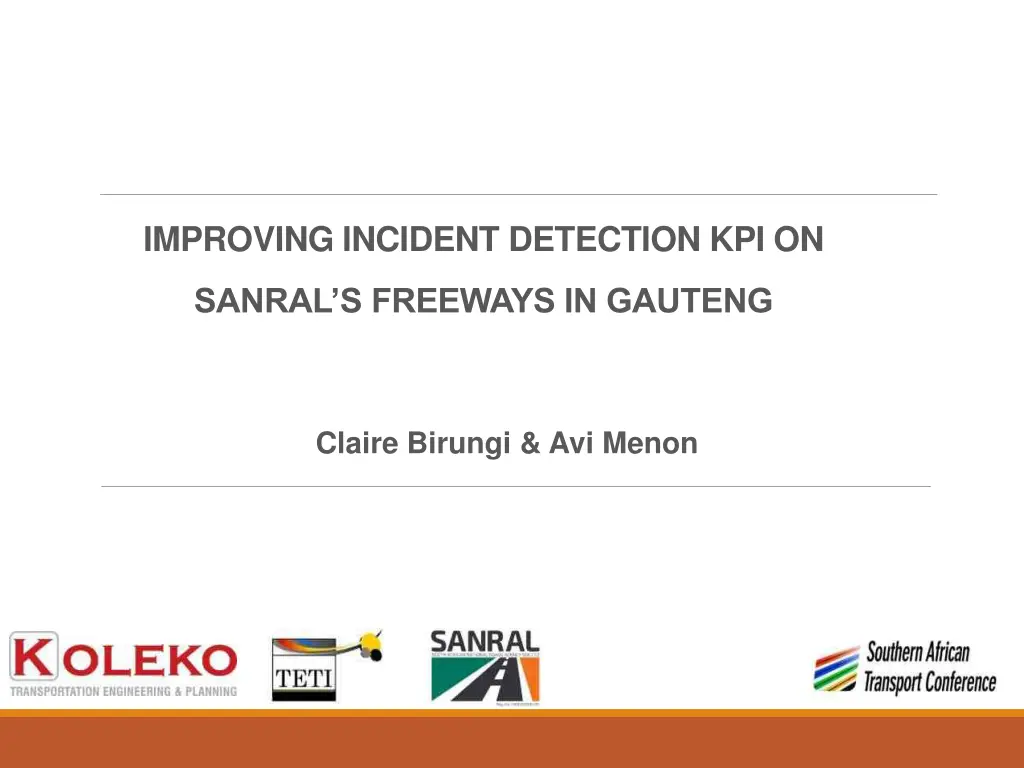
Enhancing Incident Detection Performance on SANRAL Freeways in Gauteng
Improve incident detection Key Performance Indicators (KPI) on SANRAL's freeways in Gauteng by utilizing Incident Management Systems with CCTV cameras, Variable Message Signs, and on-road response vehicles. This comprehensive approach aims to proactively identify, mitigate, and respond to traffic incidents efficiently, reducing delays and enhancing overall freeway safety and traffic flow.
Download Presentation

Please find below an Image/Link to download the presentation.
The content on the website is provided AS IS for your information and personal use only. It may not be sold, licensed, or shared on other websites without obtaining consent from the author. If you encounter any issues during the download, it is possible that the publisher has removed the file from their server.
You are allowed to download the files provided on this website for personal or commercial use, subject to the condition that they are used lawfully. All files are the property of their respective owners.
The content on the website is provided AS IS for your information and personal use only. It may not be sold, licensed, or shared on other websites without obtaining consent from the author.
E N D
Presentation Transcript
IMPROVING INCIDENT DETECTION KPI ON SANRAL S FREEWAYS IN GAUTENG Claire Birungi & Avi Menon
Background An incident is any event or occurrence that can have an impact on normal traffic flow on the freeway. Incident Management Systems include Closed Circuit Television (CCTV) cameras, Variable Message Signs (VMS), Vehicle Detection Sensors (VDS) and incident response vehicles. The purpose of IMS is to: - Identify traffic incidents - Reduce incident occurrence in a proactive and reactive way - Provide emergency response to save lives and reduce delays 2
Incident Management Systems CCTV Cameras Variable Message Signs On-Road Response Vehicles *Proactive measure to mitigate incidents *Primary role is to identify incidents on the freeway *Reactive measure to clear the scene and reduce delays 3
Detection of Incidents Operators at the Traffic Management Centre (TMC) look for traffic incidents. Over 90% of the incidents are detected using CCTV. Detection is done by manually panning, tilting and zooming each camera. Incidents identified are recorded into the ATMS. 4
Occurrence Time & Detection Time KPI Incident Occurrence Time is the actual time the incident occurred obtained by rewinding video footages. Incident Detection Time is the time when the operator detects the incident using CCTV cameras and registers it on the ATMS. Incident Detection Time Incident Occurrence Time < 3 minutes *Of the 3200 (on average per month) incidents detected in 2018, 70% do NOT have occurrence time *Limits ability to quickly respond to crashes *Decreases the efficiency of the whole network in terms of congestion and delays 5
Why Occurrence Time is Unkown The operator rarely sees the incident occurring Camera facing away from incident occurred Camera zoomed in past the incident location Manually panning through the cameras Capturing the details of the previous incident in the ATMS. 6
Manual Surveillance Method *Camera spacing varies from 400m to 1km No continuous sequential coverage The time of day, traffic volume on the section of road, known hotspot area and the number of operators available per shift. *Continuously monitoring up to 32 cameras per shift 7
Methodology Develop alternative methods of surveillance - Less cumbersome - Improve coverage - Operator efficiency To increase number of incidents detected at the time of occurrence Test the method using a before-and-after study Before period: May 2017 & After period: May 2018 During the study, the TMOs, the TMC setup, Camera type and spacing remained as existing. 8
Static-Continuous View Surveillance Position during the AM Position during the PM *Fixed position to view the entire freeway segment from end to end *Continuous and holistic view of the freeway segment. 9
Roaming View Surveillance Works effectively where: - The distance between the cameras is short enough to provide an uninterrupted view of the freeway. 10
Automated Pre-set Surveillance Freeway segments Interchange *Programming the camera to automatically zoom, tilt and pan to different viewports . *The cameras automatically cycle through these viewports allowing the operator to easily view the freeway segments 11
Comparison of the Surveillance Methods Method Pros Cons Static- continuous view surveillance Continuous and holistic view of the freeway segment; Less labour intensive. Not feasible where distance is more than 400 meters Infill cameras Roaming view surveillance Incidents on ramps may not be easily detected Continuous and quick view of the freeway; Holistic view of the roadway segment; Less labour intensive. Automated pre- set surveillance The setup of Pre-sets is time consuming View the segment or interchange within 3 minutes More than one pre-set cycle within 3 minutes. Continuous and quick view of the freeway Holistic view of the roadway segment Less labour intensive 12
Automated Pre-set Surveillance Implementation of pre-sets was conducted in March 2018 The camera is programmed to automatically view all sections of the freeway To determine viewports analysis of the following: - Traffic data analysis (volume, direction, peak period ) - Known accident hotspot areas - Camera spacing - Obstructions (overhead signboards, gantries ) - Geometry and length of the road Determine the time allocation for each viewport 13
Automated Pre-set Surveillance Pre-set time for each freeway segment (seconds) No of Monitored Freeway Segments (Viewports) Pre-set time to view all segments (seconds) No of Pre- set Tour Cycles in 3 minutes CCTV Cameras Locations/Direction CAM 551 1 3 3 12 N17 Elands I/C EB AF N17 TO N17 Germiston I/C EB BF N17/Ramp to N3 CAM 501 1 3 3 15 CAM 501 1 4 4 18 N17 WB AF N17 Germiston I/C/Ramp from N3 TO N17 WB BF N17 Elands I/C CAM 551 1 3 3 18 CAM 502 5 2 10 9 N17 EB AF N17 Germiston I/C/Ramp from N3 TO N17 Germiston I/C EB BF N17/Ramp from N3 CAM 327 5 3 10 9 14
Before & After Study May 2017 to May 2018 incidents with occurrence increase by 500 incidents The increase was normalized with the total number of incidents for each month resulting to and increase of 15% 15
Existing Shortcomings System unavailability due to power outages Distance between cameras are higher than the ideal 400m Several blind spots on the network The setup of the operators the same operator views camera footages on and also logs in data in the ATMS Bad weather conditions affect the visibility of the camera 16
Questions 17


